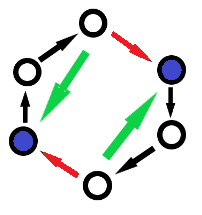1
2
3
4
5
6
7
8
9
10
11
12
13
14
15
16
17
18
19
20
21
22
23
24
25
26
27
28
29
30
31
32
33
34
35
36
37
38
39
40
41
42
43
44
45
46
47
48
49
50
51
52
53
54
55
56
57
58
59
60
61
62
63
64
65
66
67
68
69
70
71
72
73
74
75
76
77
78
79
80
81
82
83
84
85
86
87
88
89
90
91
92
93
94
95
96
97
98
99
100
101
102
103
104
105
106
107
108
109
110
111
112
113
114
115
116
117
118
119
120
121
122
123
124
125
126
127
128
129
130
131
132
133
134
| // __________________
// | ________________ |
// || ____ ||
// || /\ | ||
// || /__\ | ||
// || / \ |____ ||
// ||________________||
// |__________________|
// \###################\
// \###################\
// \ ____ \
// \_______\___\_______\
// An AC a day keeps the doctor away.
#pragma g++ optimize("Ofast")
#pragma loop_opt(on)
#include <bits/extc++.h>
#ifdef local
#define debug(x) (cerr<<#x<<" = "<<(x)<<'\n')
#else
#define debug(x) ((void)0)
#endif // local
using namespace std;
typedef int64_t ll;
constexpr ll N = 100025, INF = 1e18, MOD = 998244353, K = 64, inf = 1e9;
struct Splay {
struct node {
int ch[2],pa;
int lf[2];
// lf[0] is the leftmost element of this splay, lf[1] is the rightmost
} T[N];
void pull(int i){
T[i].lf[0] = T[i].ch[0] ? T[T[i].ch[0]].lf[0] : i;
T[i].lf[1] = T[i].ch[1] ? T[T[i].ch[1]].lf[1] : i;
}
bool isroot(int x){return T[x].pa==0;}
bool dir(int x){return T[T[x].pa].ch[1] == x;}
void rot(int x) {
int y = T[x].pa, z = T[y].pa, d = dir(x);
T[x].pa = z;
if(!isroot(y)) T[z].ch[dir(y)] = x;
T[T[x].ch[!d]].pa = y, T[y].ch[d] = T[x].ch[!d];
T[x].ch[!d] = y, T[y].pa = x;
}
int splay(int x) {
while(!isroot(x)) {
int y = T[x].pa;
if(!isroot(y)) {
if(dir(x) ^ dir(y))
rot(x);
else
rot(y);
}
rot(x);
}
return T[x].lf[0];
//like DSU, present a tree with unique element(leftmost)
}
// (A..., x, B...) -> (A...) + (x, B...)
int cut(int x) {
splay(x);
int res = T[x].ch[0];
T[T[x].ch[0]].pa = 0, T[x].ch[0] = 0, T[x].lf[0] = x;
return res;
}
// (A..., x, B...) + (C..., y, D...) -> (x, B...C..., y, D...A...)
void link(int x, int y) {
if(!x || !y || splay(x) == splay(y)) return;
x = T[x].lf[1], y = T[y].lf[0];
splay(x), splay(y);
T[y].pa = x, T[x].ch[1] = y;
splay(y);
}
int poke(int x,int y) {
if(splay(x) == splay(y)) {
// (A..., x, B..., y, C...) -> (x, B...) + (y, C...A...)
int a = cut(x);
link(x,a);
cut(y);
return -1;
}else {
// (A..., x, B...) + (C..., y, D...) -> (x, B...A..., y, D...C...)
int a = cut(x);
int b = cut(y);
link(x,a);
link(y,b);
link(x,y);
return 1;
}
}
void init(int n) {
for(int i = 1; i <= n; i++)
T[i].lf[0] = T[i].lf[1] = i, T[i].pa = T[i].ch[0] = T[i].ch[1] = 0;
}
/*void dfs(int i) {
if(!i) return;
dfs(T[i].ch[0]);
cout << i << ' ';
dfs(T[i].ch[1]);
}
void dbg(int n) {
//return;
cout << "===\n";
for(int i = 1; i <= n; i++) if(isroot(i)) dfs(i), cout << '\n';
cout << "===\n\n";
}*/
} cycles;
int n,q,v[N],vis[N],pos[N],ans;
signed main() {
ios_base::sync_with_stdio(0), cin.tie(0);
cin >> n >> q;
cycles.init(n);
for(int i = 1; i <= n; i++) cin >> v[i], pos[v[i]] = i;
for(int i = 1; i <= n; i++) if(!vis[i]) {
int last = 0;
for(int x = i; !vis[x]; x = pos[x]) {
if(last) ans += cycles.poke(v[last],v[x]);
vis[x] = 1;
last = x;
}
}
cout << ans << '\n';
//tr.dbg(n);
//return 0;
while(q--) {
int a,b;
cin >> a >> b;
ans += cycles.poke(a,b);
cout << ans << '\n';
//tr.dbg(n);
}
}
|
